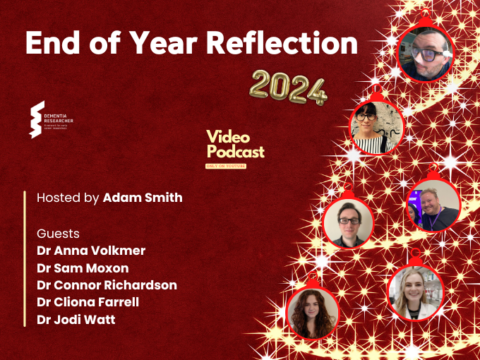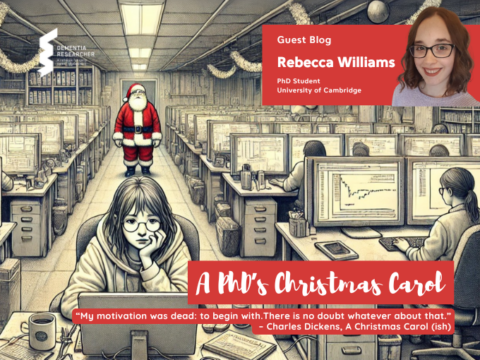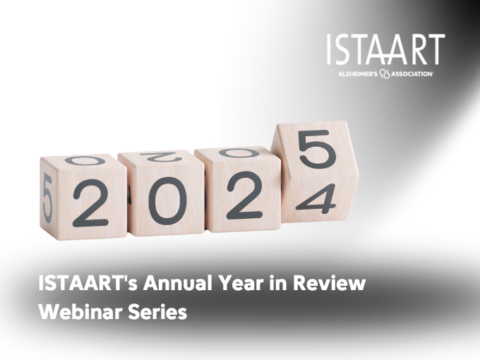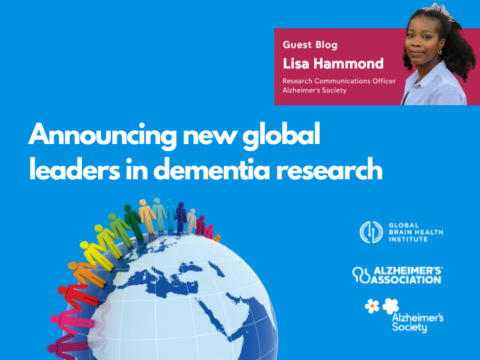Research into cognitive reserve holds a special place in my heart as a dementia researcher, it was the topic of my MSc dissertation, first research project, and paper in the field. Ultimately, it led me into my career now as a dementia epidemiologist. I haven’t revisited the topic in almost 10 years, so dipping my toe back in to write this blog was a great chance to see how this field has changed, the new frontiers opening up, and some of the recognizable challenges that remain today.
The year in review was moderated by Harriet Demnitz-King of University College London. The session began with a review of seminal papers of 2023 delivered by Natalia Goncalves, University of Sao Paulo, and a discussion with panellists David Bartres Faz, Brian T. Gold, and Joao Victor Rocha. In this blog, I will give an overview of the papers discussed and sum up the main points of discussion that came after, peppered with some of my own thoughts throughout.
The first paper Natalia presented was by Yakov Stern et al., whom I immediately recognized as one of the pioneers of reserve theory. It was a great starting point for the review as it cut straight to one of the biggest problems in reserve, which is still an issue from my research, that is actually defining what reserve is. This sounds simple at first, until you realize that many researchers are trying their best across the world to measure a concept using their own interpretation of how to measure it, an issue that comes up in epidemiology time and again.
Stern proposes that the term ‘Resilience’ be used as an umbrella to describe any concept that relates to the capacity of the brain to maintain cognition and function with ageing and disease. There can be mechanisms underpinning resilience, and the paper describes three: Cognitive Reserve, Brain Maintenance, and Brain Reserve.
I can often find these more abstract definitions a little frustrating, but Natalia summarized them nicely.
Resilience – she explained, is the brain’s ability to maintain cognition and function despite ageing and disease.
Cognitive reserve – represents the brain’s capacity to perform better than expected given the degree of age-related changes or brain injury.
Brain maintenance – is the absence of changes in neural resources over time, is a determinant of preserved cognitive function in older age.
Protective factors
The next paper gave a biological perspective on protective factors, with findings suggesting astrocyte reactivity emerged as a crucial factor influencing tau pathology in preclinical Alzheimer’s disease. Lower astrocyte reactivity was associated with lower tau pathology. Interestingly, this was more notable in men than women. The authors of this paper suggest it could have implications for the biological preclinical definition of AD going forward.
Resilience
The focus of the session then moved on to the key papers of the year covering resilience. The first of which I personally found really interesting as it’s almost the direct opposite of the kind of paper I would ever come across. In comparison to my usual epidemiology papers of large populations, Natalia presented a case study of a single man. The paper characterized a man who retained cognitive functioning until aged 67 while being a carrier of a PSEN1-E280A genetic mutation, which causes Autosomal Dominant Alzheimer’s Disease (ADAD). Now, I’m not qualified to understand details of the case, but in light of carriers of his mutation on average developing MCI by age 44 and dementia by age 49 with rare exceptions it piqued my interest. The paper digs deeper into possible neuroimaging, genetic and neuropathological characteristics associated with his cognitive resilience.
Natalia’s next paper was more familiar to me, a longitudinal analysis of demographic, structural and biological factors associated with cognitive and brain resilience to tau pathology specifically. They found that education was the strongest determinant of both cognitive and brain resilience against tau pathology. Suggesting, education may be protective against cognitive decline at lower levels of tau pathology. The last paper on resilience was also a longitudinal analysis on the effect of the Mediterranean diet on cognitive resilience. They found that the diet was associated with both higher cognition and slower rates of cognitive decline.
Reserve
Finally, Natalia ended her portion of the talk with key papers in Reserve. One that stood out to me was a paper by Seyedsalehi et al. using Mendelian Randomization analysis to better understand how higher educational attainment observed in many studies being protective against dementia pathology is underpinned. Their findings support higher education as a casual protective factor for the risk of dementia. Further to this, they found education to be associated with macro and micro brain structures, however there was no effect on dementia risk from this, suggesting the effect from education is being mediated through alternate features of brain reserve.
Discussion
After the presentation of these papers, there was a fascinating discussion between David Bartres Faz, Brian T. Gold, and Joao Victor Rocha, moderated by Harriet Demnitz-King.
The discussion started out by discussing from the speakers personal highlights of the year in reserve research. The new findings of reserve and resilience research applied to tau pathology were quickly picked up. The group reflected on up until now the vast majority of focus has been placed on the importance of amyloid and in many ways we are catching up to understanding the effect of reserve on tau as the more destructive of the two pathologies. There was also discussion of how this might be a chance to expand further into the effect of reserve on proteinopathies too.
It was interesting to hear some of the same challenges being discussed as there were when I was researching reserve 8 years ago. Firstly, the group discussed the pitfalls of education still being used as a proxy for reserve, due to it also being a proxy for other healthy lifestyle factors. Personally, I am more relaxed about this one, I’m more persuaded by the evidence of education showing to have an effect independent of other lifestyle factors.
There was a big discussion on the degree of heterogeneity between studies of reserve. Even in light of the definitions put forward by Yakov and Stern at the beginning of this blog, CR is always operationalized in studies differently to some degree and using different populations and samples of individuals, not to mention the differences in methods used to measure study characteristics. To an epidemiologist, this is a problem as old as time and creeps into all quantitative studies of dementia and many other conditions. I have most experience of this myself when researching mild cognitive impairment; it seems that we focus a lot on defining and redefining the diagnosis of dementia however we seem much further behind in defining the spectrum of cognition and cognitive decline in general.
On the bright side, however, we are seeing more and more diversity in terms of the populations being investigated. It was noted in the discussion how heartening it is to see a number of under-represented groups included in the papers, from low and middle-income countries to the inclusion of those with learning difficulties.
In all, I really enjoyed being a part of the webinar. Reserve is a fascinating PIA covering a number of disciplines, from bench science, epidemiology through to social science. It gave me a chance to get a taste of different types of studies and methodologies I wouldn’t normally come across. Although there are some who find the discussions of defining a thing frustrating, I also find it exciting, hearing the debate and experts putting their case forward. And there looks to be exciting projects for the future in this space, for me specifically, the intersection of reserve into brain structure and pathologies.

Dr Connor Richardson
Author
Dr Connor Richardson is a Neuro-epidemiology Research Associate in the Newcastle University Population Health Sciences Institute. Connor is the research statistician for the Cognitive Function and Ageing studies (CFAS) multi-centre population cohort. His research interest lies in using advanced statistical modelling and machine learning to measure dementia risk. Connor blogs about his research, Equality, Diversity and Inclusion and sometimes his Pomapoo’s.

 Print This Post
Print This Post






